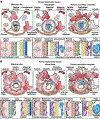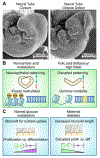Maternal metabolism influences neural tube closure
- PMID: 37468429
- PMCID: PMC10529122
- DOI: 10.1016/j.tem.2023.06.005
Maternal metabolism influences neural tube closure
Abstract
Changes in maternal nutrient availability due to diet or disease significantly increase the risk of neural tube defects (NTDs). Because the incidence of metabolic disease continues to rise, it is urgent that we better understand how altered maternal nutrient levels can influence embryonic neural tube development. Furthermore, primary neurulation occurs before placental function during a period of histiotrophic nutrient exchange. In this review we detail how maternal metabolites are transported by the yolk sac to the developing embryo. We discuss recent advances in understanding how altered maternal levels of essential nutrients disrupt development of the neuroepithelium, and identify points of intersection between metabolic pathways that are crucial for NTD prevention.
Keywords: folate; glucose; maternal–fetal communication; neural tube; yolk sac.
Copyright © 2023 Elsevier Ltd. All rights reserved.
Conflict of interest statement
Declaration of interests Authors declare no conflicts of interest.
Figures




Similar articles
-
Maternal dietary uridine causes, and deoxyuridine prevents, neural tube closure defects in a mouse model of folate-responsive neural tube defects.Am J Clin Nutr. 2015 Apr;101(4):860-9. doi: 10.3945/ajcn.114.097279. Epub 2015 Jan 28. Am J Clin Nutr. 2015. PMID: 25833982 Free PMC article.
-
Folate-mediated one-carbon metabolism and neural tube defects: balancing genome synthesis and gene expression.Birth Defects Res C Embryo Today. 2007 Sep;81(3):183-203. doi: 10.1002/bdrc.20100. Birth Defects Res C Embryo Today. 2007. PMID: 17963270 Review.
-
Insights into metabolic mechanisms underlying folate-responsive neural tube defects: a minireview.Birth Defects Res A Clin Mol Teratol. 2009 Apr;85(4):274-84. doi: 10.1002/bdra.20553. Birth Defects Res A Clin Mol Teratol. 2009. PMID: 19180567 Free PMC article. Review.
-
Metabolite profiling of whole murine embryos reveals metabolic perturbations associated with maternal valproate-induced neural tube closure defects.Birth Defects Res. 2017 Jan 30;109(2):106-119. doi: 10.1002/bdra.23583. Birth Defects Res. 2017. PMID: 27860192 Free PMC article.
-
The visceral yolk sac endoderm provides for absorption of nutrients to the embryo during neurulation.Birth Defects Res A Clin Mol Teratol. 2010 Aug;88(8):593-600. doi: 10.1002/bdra.20705. Birth Defects Res A Clin Mol Teratol. 2010. PMID: 20672346 Review.
Cited by
-
Maternal Myo-Inositol Deficiency Involved Autophagy Impairment by PI3K/Akt/mTOR Signaling in Neural Tube Defects During Pregnancy.Mol Neurobiol. 2025 Sep;62(9):11529-11543. doi: 10.1007/s12035-025-04972-9. Epub 2025 Apr 28. Mol Neurobiol. 2025. PMID: 40293706
-
Integrative Analysis of Key Signalling Pathways in Neural Tube Defects: From Molecular Mechanisms to Therapeutic Strategies.Int J Dev Neurosci. 2025;85(6):e70051. doi: 10.1002/jdn.70051. Int J Dev Neurosci. 2025. PMID: 40898587 Free PMC article. Review.
-
Noncanonical function of folate through folate receptor 1 during neural tube formation.Nat Commun. 2024 Feb 22;15(1):1642. doi: 10.1038/s41467-024-45775-1. Nat Commun. 2024. PMID: 38388461 Free PMC article.
-
Deciphering the enigma of the function of alpha-tocopherol as a vitamin.Free Radic Biol Med. 2024 Aug 20;221:64-74. doi: 10.1016/j.freeradbiomed.2024.05.028. Epub 2024 May 15. Free Radic Biol Med. 2024. PMID: 38754744 Free PMC article.
-
Evidence of the correlation between air pollution and different types of birth defects: based on a distribution-lag non-linear model.Front Public Health. 2025 Apr 9;13:1562461. doi: 10.3389/fpubh.2025.1562461. eCollection 2025. Front Public Health. 2025. PMID: 40270732 Free PMC article.
References
Publication types
MeSH terms
Substances
Grants and funding
LinkOut - more resources
Full Text Sources
Medical

